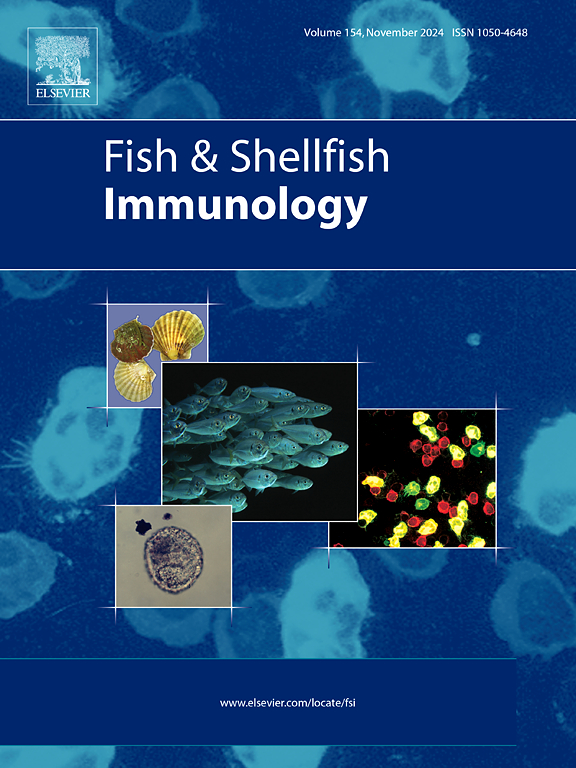Study on the correlation between Flavobacterium columnare infection and gill injury in Largemouth bass (Micropterus salmoides) and the protective effect of Enoxolone
IF 4.1
2区 农林科学
Q1 FISHERIES
引用次数: 0
Abstract
Columnaris disease, caused by Flavobacterium columnare, has a broad host range and can afflict multiple families and genera of freshwater fish. In addition, our prior research found that Enoxolone emerged as the most promising candidate with a low minimum inhibitory concentration and good cost-effectiveness. However, the therapeutic effect of Enoxolone on Micropterus salmoides infected with F. columnare remains unclear, and its antibacterial efficiency in vivo has yet to be investigated. In this study, we found that the cumulative mortality rate of M. salmoides reached 70 % within 96 h post-infection with 1 × 108 CFU/mL F. columnare, and the gills exhibited clinical signs such as paleness and ischemia, accompanied by characteristic "Clavate Gill" pathological changes. Meanwhile, both the severity of these lesions and the bacterial load showed a significantly upward trend over time. In addition, following Enoxolone treatment, the mortality rate of M. salmoides infected by F. columnare was reduced by 40 %, with alleviated general pathological changes and a significantly lower number of apoptotic positive cells compared to the infected but untreated group. The relative expression of apoptosis and inflammation-related genes showed that the expression levels of Caspase-9, IL-18, TNF-α and NF-κB were significantly upregulated after F. columnare infection. However, the relative expression of Bcl-2 and IL-10 was significantly upregulated after treatment with Enoxolone. In conclusion, there was a positive correlation between the F. columnare load and gill damage in M. salmoides. In addition, Enoxolone has potential therapeutic and protective effects against gill tissue damage caused by F. columnare. Presumably, this efficacy may stem from the drug's ability to inhibit bacteria, thereby reducing gill cell apoptosis and inflammation. These findings provide new perspectives for future research and establish a groundwork for devising preventive and curative strategies against F. columnare infections.
大口黑鲈柱状黄杆菌感染与鳃损伤的相关性及依诺洛酮的保护作用研究
柱状黄杆菌病由柱状黄杆菌引起,宿主范围广泛,可影响多个科和属的淡水鱼。此外,我们之前的研究发现依诺洛酮最低抑制浓度低,成本效益好,是最有希望的候选药物。然而,依诺洛酮对柱状假单胞菌感染的沙门小蝶的治疗效果尚不清楚,其体内抗菌效果尚待研究。本研究发现,1 × 108 CFU/mL柱状棘球蚴感染后96 h内累计死亡率达70%,鳃呈现苍白、缺血等临床症状,并伴有特征性的“棍状鳃”病理改变。同时,随着时间的推移,这些病变的严重程度和细菌负荷都呈现出明显的上升趋势。此外,在依诺洛酮治疗后,与感染但未治疗组相比,柱状梭状芽胞杆菌感染的salmoides死亡率降低了40%,一般病理改变减轻,凋亡阳性细胞数量明显减少。细胞凋亡和炎症相关基因的相对表达表明,柱状梭菌感染后Caspase-9、IL-18、TNF-α和NF-κB的表达水平显著上调。而依诺洛酮治疗后,Bcl-2和IL-10的相对表达量明显上调。综上所述,柱状棘球蚴负荷与棘球蚴鳃损伤呈正相关。此外,依诺洛酮对柱状假单胞菌引起的鳃组织损伤具有潜在的治疗和保护作用。据推测,这种功效可能源于药物抑制细菌的能力,从而减少鳃细胞凋亡和炎症。这些发现为今后的研究提供了新的视角,并为制定柱状梭菌感染的预防和治疗策略奠定了基础。
本文章由计算机程序翻译,如有差异,请以英文原文为准。
求助全文
约1分钟内获得全文
求助全文
来源期刊

Fish & shellfish immunology
农林科学-海洋与淡水生物学
CiteScore
7.50
自引率
19.10%
发文量
750
审稿时长
68 days
期刊介绍:
Fish and Shellfish Immunology rapidly publishes high-quality, peer-refereed contributions in the expanding fields of fish and shellfish immunology. It presents studies on the basic mechanisms of both the specific and non-specific defense systems, the cells, tissues, and humoral factors involved, their dependence on environmental and intrinsic factors, response to pathogens, response to vaccination, and applied studies on the development of specific vaccines for use in the aquaculture industry.
 求助内容:
求助内容: 应助结果提醒方式:
应助结果提醒方式:


